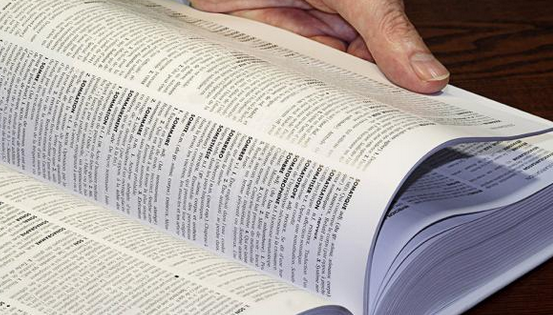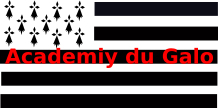
Linguistic Files of the Academy of Gallo
Cards of Standardization for Gallo

 Linguistic Files of the Academy of GalloCards of Standardization for Gallo |
You are not logged in : no training follow-up recorded
The Academy of Gallo often uses this digram. Few other Latin languages use it.
Among the most notable languages of Western Europe, German is about the only one that makes regular use of it, to mark the /ɛ/ phoneme in particular.
In Gallo, its attestation is found in two different, specific and fairly frequent cases:
Let's turn immediately to their French equivalents: -é for the first case and -ai for the second. As French is the most widely recognized close language, this will help us understand the path that leads to a common digram in Gallo.
The past participle of the first-group verbs we know so well has its origins in the Latin -at in the accented position.
The Latin cantat (fr chanté) will serve as a guideline to explain its evolution. We find cantato in Italian, cântat in Romanian, cantado in Castilian and Portuguese, cantat in Catalan and Occitan.
From this Cantat source, we can see that the Mediterranean region has sometimes added an unintense vowel. Only Romanian, Catalan and Occitan have retained the original disincent. But in all cases, the initial vowel remains unchanged.
Moving northwards, the situation was different. Around 1100, northern Romania began to bend the accented -a to -é, then to de-emphasize the final consonant -t.
That's why, in modern French, we hear it chanté (english sung).
However, in the west, notably in Upper Brittany, but also in Maine and on the outskirts of Anjou and Normandy, this bending continued until it settled on the central vowel /ɘ/ (french e sound in petit (small)).
However, in Upper Brittany, this central vowel /ɘ/ is not uniform, and on the periphery we find /e/, /ɛ/ or even a diphthong to the south and west of Nantes.
We'll therefore see chantae, sonjae, avanjae, envyae. Alongside the pronunciations /ʃãtɘ/, /sõjɘ/, /avãʒɘ/, /ãvjɘ/, the pronunciations /ɛ/ ou /aj/ are not far off.
This spelling extends in conjugation to the first person of the indicative of the verb avair (j'ae), and is also used in the same place in the disinence of the future simple (j'arae).
This final pronunciation extends to all Latin words with a de-emphasized /a/ vowel. This is the case for a number of nouns such as maitiae, prae, pitiae,... or with suffixes in -ae (cllertae, duretae, aghuzetae, ...), hence the same spelling for all.
This spelling -ae is also found in integrated where French often uses the digraph -ai (maison, faire, ...). We'll see why.
Starting with Latin once again, we find an -a at the origin. Then, at the end of the 9th century, this -a formed a diphthong /aj/ in northern Romance languages.
None of this happens around the Mediterranean:
So it's only logical that we should find the -ai spelling in French. But this diphthong was gradually reduced to /e/ or /ɛ/ in the 12th century.
Gallo is undergoing the same evolution. So, a priori, we could build our spelling simply with the vowel -e, which we'd accentuate on demand.
The situation is more complex.
First of all, remember that in Gallo, the consonants /s/ and /z/ lead to inflections of the preceding vowel. Thus, a pronunciation in /ɛ/ (aer, aele) will flex into /e/ before these two consonants: /mezɘ/ (maezei), /gres/ (graesse), /tʃes/ (qhaece), ...
On the other hand, in some cases there is still a local diphthong.
It therefore seems logical that terms evolving from this etymological vowel /a/, while revealing their phonetic evolution, should adopt it. This is all the more true as the initial vowel is found in derivations:
Conversely, derivatives in -ae can refer to an etymon in -a:
This evolution of /a/ into /ɛ/ or /e/, although widespread, has not been uniformly adopted by French. A few terms that escape it are nevertheless caught up in Gallo:
This flexion occasionally extends to terms of Germanic origin:
Suffixes containing this -ae (-aere, -aezon) are also subject to the same flexions:
Exceptionally, the suffix -aez, derived from a cross between Latin -ensus and Frankish -isk, departs from this lineage.
To sum up, we have three global phonetic treatments of the digram -ae, which we can group together in this table:
| Position | Pronunciation | Variants | Examples |
|---|---|---|---|
| in the final | /ɘ/ | /aj/, /œj/ | chantae, onestae |
| inserted in front /s/ & /z/ | /e/ | /aj/, /ɛ/, /a/ | baesser, qhaece, saezon |
| inserted before another consonant | /ɛ/ | /aj/, /ɛ/, /ɘ/ | aer, pllaeder |
In addition, this -ae can be nasalized (-aem, -aen) or lengthened, movements that will be dealt with in specific articles.